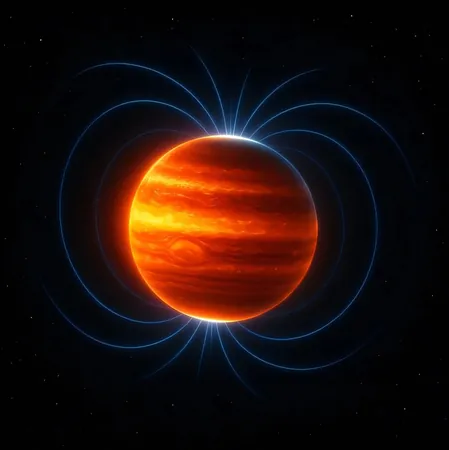
Unlocking the Secrets of Young Jupiter: The Architect of Our Solar System
2025-05-28
Author: Yu
Long before Earth's first continents emerged, Jupiter stood as a colossal force, meticulously shaping our solar system's layout.
The infant gas giant wielded its immense gravity to sculpt the swirling disc of gas and dust surrounding the young Sun, forming gaps, stabilizing smaller celestial bodies, and establishing the architecture we recognize today. Yet, the intricacies of Jupiter's early history remained elusive.
A New Study Uncovers Jupiter’s Origins
Recent research offers unprecedented insights into Jupiter’s primordial characteristics—its size, rotation, and magnetic strength—shedding light on the cosmic saga of our planetary neighborhood.
Jupiter: The Solar System's Engineer
According to astrophysicists Konstantin Batygin of Caltech and Fred C. Adams from the University of Michigan, Jupiter’s gravitational influence can be likened to that of an architect, carefully designing the paths of planets.
Once Jupiter achieved significant mass, its gravitational pull directed the orbits of nearby planets, from Mercury's tight trajectory to the icy realms beyond Neptune. Understanding when and how Jupiter grew is crucial for deciphering the arrangement of our solar system.
Exploring Jupiter’s Early Years
Previous research often relied on complex computer simulations of rocky bodies gathering gas, which is subject to numerous uncertainties. Batygin and Adams took a fresh approach by examining a pivotal moment roughly 3.8 million years after the first solid grains formed in the proto-solar nebula.
By that time, as the surrounding gas was thinning out, Jupiter had largely completed its growth. Yet, the real clues lay hidden in its small moons, Amalthea and Thebe.
Clues from Jupiter’s Tiny Moons
These moons, situated closer to Jupiter than the volcanic moon Io, boast slightly tilted orbits—tiny deviations that reveal insights into the planet's early size. Through celestial mechanics, the researchers discovered that Jupiter's early radius was approximately twice that of its current size, equating to a massive volume more than 2,000 times that of Earth.
This inflated size bears resemblance to 'puffy' gas giants observed around young stars, creating a bridge between our solar system and exoplanetary discoveries.
A Supercharged Youth
The same analyses revealed that in its youth, Jupiter possessed a magnetic field nearly 50 times stronger than what NASA's Juno spacecraft detects today. Such a powerful magnetic field suggests an intensely active metallic-hydrogen core and potentially a faster rotation than its already rapid 10-hour day.
Understanding Planet Formation
Recognizing the precise timing of Jupiter's early development is key to understanding the solar system's architecture. As solar radiation cleared out hydrogen and helium from the nebula, the growth of giant planets tapered off, and the smaller bodies that evolved into asteroids and comets found their places.
By accurately capturing Jupiter's properties at this critical juncture, researchers can establish solid foundations for future planetary formation models.
Rewiring the Planet Formation Narrative
Current theories suggest gas giants form through core accretion, with the planet pulling in a vast gaseous envelope after accumulating a substantial rocky core. This recent study endorses and refines this model, showing that Jupiter remained in its bloated state for several million years before gradually cooling to its current size.
This prolonged phase likely allowed Jupiter to influence the paths of other planets like Saturn, Uranus, and Neptune, as well as ejecting icy bodies into the far reaches of the solar system, where the Oort Cloud now resides.
A Benchmark for Future Research
Although the very beginnings of Jupiter’s core formation remain unclear, this study establishes a crucial benchmark in the timeline of solar system evolution. By analyzing the orbital inclinations of its tiny moons, astronomers have opened a portal to glimpse the dynamics of the early solar system.
The findings reveal a young Jupiter, twice its current girth and enveloped by a magnetic field far stronger than anything we observe today, expertly navigating the chaotic environment toward the harmonious solar system we inhabit now.
This breakthrough adds a vital piece to the puzzle of our cosmic history, offering insights into not only Jupiter's origins but also the formation of our entire solar system, laying the groundwork for future explorations.
The research has been published in the esteemed journal Nature Astronomy.





 Brasil (PT)
Brasil (PT)
 Canada (EN)
Canada (EN)
 Chile (ES)
Chile (ES)
 Česko (CS)
Česko (CS)
 대한민국 (KO)
대한민국 (KO)
 España (ES)
España (ES)
 France (FR)
France (FR)
 Hong Kong (EN)
Hong Kong (EN)
 Italia (IT)
Italia (IT)
 日本 (JA)
日本 (JA)
 Magyarország (HU)
Magyarország (HU)
 Norge (NO)
Norge (NO)
 Polska (PL)
Polska (PL)
 Schweiz (DE)
Schweiz (DE)
 Singapore (EN)
Singapore (EN)
 Sverige (SV)
Sverige (SV)
 Suomi (FI)
Suomi (FI)
 Türkiye (TR)
Türkiye (TR)
 الإمارات العربية المتحدة (AR)
الإمارات العربية المتحدة (AR)